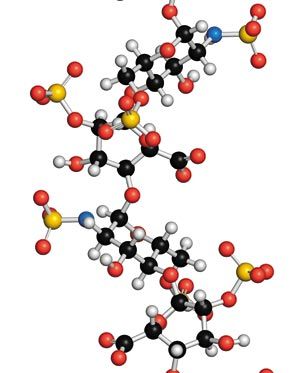High-Throughput Screening of Heparin Using LC–MS
Researchers have published a new approach to heparin screening that allows the detection of adulteration within one hour. Published in the journal Analytical Chemistry, the study presents a screening strategy using hydrogen peroxide digestion followed by fast reversed-phase ion pairing liquid chromatography (reversed-phase IP–LC) coupled with tandem mass spectrometry (MS–MS) to detect contamination of heparin samples.
Researchers have published a new approach to heparin screening that allows the detection of adulteration within one hour. Published in the journal Analytical Chemistry, the study presents a screening strategy using hydrogen peroxide digestion followed by fast reversed-phase ion pairing liquid chromatography (reversed-phase IP–LC) coupled with tandem mass spectrometry (MS–MS) to detect contamination of heparin samples.1
Photo Credit: MOLEKUUL/SCIENCE PHOTO LIBRARY/Getty Images

Heparin is a complex carbohydrate that is commonly used as a blood thinner in drug formulation and as a coating on medical devices. Between 2007–2008, contamination of heparin with oversulphated chondroitin sulphates (OSCs) led to 94 deaths and 574 adverse reactions in the USA alone, highlighting a need for accurate and sensitive analytical methods to screen heparin.1 Corresponding author Peter Nemes from George Washington University (Washington D.C., USA) told The Column: “My goal is to develop new analytical technologies and methodologies that advance tests to higher throughput, specificity, and sensitivity so that a larger number of products can be tested to help preserve and advance human health. Encouraged by the performance of pyrolysis mass spectrometry,2 a technology that we also recently developed along this mission, my colleagues and I wanted to further enhance the specificity of detecting a potential contaminant.”
The study authors developed a sample preparation method using chemical treatment using hydrogen peroxide combined with heating to break down 50 μg samples of heparin, including oversulphated chondroitin sulphates (OSCs), into smaller fragments. The resulting oligomers were then separated using reversed-phase IP–LC and analyzed using MS. The method was then applied to samples collected by the FDA during the heparin contamination incident in 2007–2008 to show that it could differentiate between safe and contaminated samples. Nemes told The Column: “In comparison to current mass spectrometry protocols that typically require several hours-to-days for sample preparation and instrumental analysis time, our approach is completed in 60 minutes - from start to finish - allowing us to quality-test a given sample in higher throughput.”
In terms of future work, Nemes told The Column: “My goal is to continue advancing analytical measurements to higher sensitivity, specificity, and compatibility to volume/mass-limited samples so that even trace-level compounds can be measured in extremely small amounts of samples.” - B.D.
References
- Hong Li et al., Analytical Chemistry87, 8424−8432 (2015).
- P. Nemes et al., Analytical Chemistry 85, 7405–7412 (2013).

Polysorbate Quantification and Degradation Analysis via LC and Charged Aerosol Detection
April 9th 2025Scientists from ThermoFisher Scientific published a review article in the Journal of Chromatography A that provided an overview of HPLC analysis using charged aerosol detection can help with polysorbate quantification.
Analyzing Vitamin K1 Levels in Vegetables Eaten by Warfarin Patients Using HPLC UV–vis
April 9th 2025Research conducted by the Universitas Padjadjaran (Sumedang, Indonesia) focused on the measurement of vitamin K1 in various vegetables (specifically lettuce, cabbage, napa cabbage, and spinach) that were ingested by patients using warfarin. High performance liquid chromatography (HPLC) equipped with an ultraviolet detector set at 245 nm was used as the analytical technique.
Removing Double-Stranded RNA Impurities Using Chromatography
April 8th 2025Researchers from Agency for Science, Technology and Research in Singapore recently published a review article exploring how chromatography can be used to remove double-stranded RNA impurities during mRNA therapeutics production.










